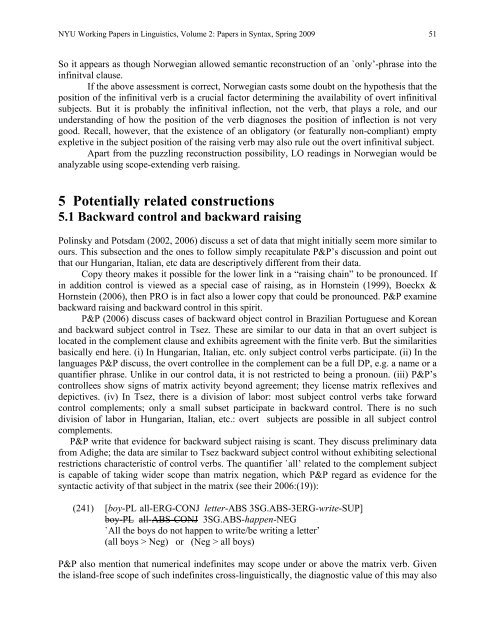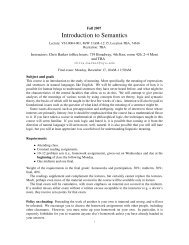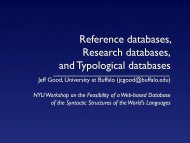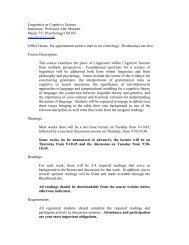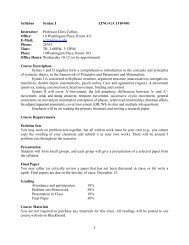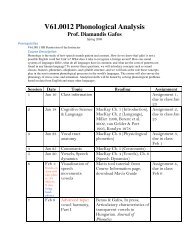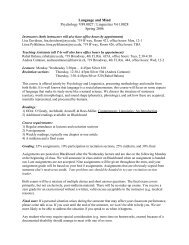Overt Nominative Subjects in Infinitival Complements Cross - NYU ...
Overt Nominative Subjects in Infinitival Complements Cross - NYU ...
Overt Nominative Subjects in Infinitival Complements Cross - NYU ...
You also want an ePaper? Increase the reach of your titles
YUMPU automatically turns print PDFs into web optimized ePapers that Google loves.
<strong>NYU</strong> Work<strong>in</strong>g Papers <strong>in</strong> L<strong>in</strong>guistics, Volume 2: Papers <strong>in</strong> Syntax, Spr<strong>in</strong>g 2009 51So it appears as though Norwegian allowed semantic reconstruction of an `only’-phrase <strong>in</strong>to the<strong>in</strong>f<strong>in</strong>itval clause.If the above assessment is correct, Norwegian casts some doubt on the hypothesis that theposition of the <strong>in</strong>f<strong>in</strong>itival verb is a crucial factor determ<strong>in</strong><strong>in</strong>g the availability of overt <strong>in</strong>f<strong>in</strong>itivalsubjects. But it is probably the <strong>in</strong>f<strong>in</strong>itival <strong>in</strong>flection, not the verb, that plays a role, and ourunderstand<strong>in</strong>g of how the position of the verb diagnoses the position of <strong>in</strong>flection is not verygood. Recall, however, that the existence of an obligatory (or featurally non-compliant) emptyexpletive <strong>in</strong> the subject position of the rais<strong>in</strong>g verb may also rule out the overt <strong>in</strong>f<strong>in</strong>itival subject.Apart from the puzzl<strong>in</strong>g reconstruction possibility, LO read<strong>in</strong>gs <strong>in</strong> Norwegian would beanalyzable us<strong>in</strong>g scope-extend<strong>in</strong>g verb rais<strong>in</strong>g.5 Potentially related constructions5.1 Backward control and backward rais<strong>in</strong>gPol<strong>in</strong>sky and Potsdam (2002, 2006) discuss a set of data that might <strong>in</strong>itially seem more similar toours. This subsection and the ones to follow simply recapitulate P&P’s discussion and po<strong>in</strong>t outthat our Hungarian, Italian, etc data are descriptively different from their data.Copy theory makes it possible for the lower l<strong>in</strong>k <strong>in</strong> a “rais<strong>in</strong>g cha<strong>in</strong>” to be pronounced. If<strong>in</strong> addition control is viewed as a special case of rais<strong>in</strong>g, as <strong>in</strong> Hornste<strong>in</strong> (1999), Boeckx &Hornste<strong>in</strong> (2006), then PRO is <strong>in</strong> fact also a lower copy that could be pronounced. P&P exam<strong>in</strong>ebackward rais<strong>in</strong>g and backward control <strong>in</strong> this spirit.P&P (2006) discuss cases of backward object control <strong>in</strong> Brazilian Portuguese and Koreanand backward subject control <strong>in</strong> Tsez. These are similar to our data <strong>in</strong> that an overt subject islocated <strong>in</strong> the complement clause and exhibits agreement with the f<strong>in</strong>ite verb. But the similaritiesbasically end here. (i) In Hungarian, Italian, etc. only subject control verbs participate. (ii) In thelanguages P&P discuss, the overt controllee <strong>in</strong> the complement can be a full DP, e.g. a name or aquantifier phrase. Unlike <strong>in</strong> our control data, it is not restricted to be<strong>in</strong>g a pronoun. (iii) P&P’scontrollees show signs of matrix activity beyond agreement; they license matrix reflexives anddepictives. (iv) In Tsez, there is a division of labor: most subject control verbs take forwardcontrol complements; only a small subset participate <strong>in</strong> backward control. There is no suchdivision of labor <strong>in</strong> Hungarian, Italian, etc.: overt subjects are possible <strong>in</strong> all subject controlcomplements.P&P write that evidence for backward subject rais<strong>in</strong>g is scant. They discuss prelim<strong>in</strong>ary datafrom Adighe; the data are similar to Tsez backward subject control without exhibit<strong>in</strong>g selectionalrestrictions characteristic of control verbs. The quantifier `all’ related to the complement subjectis capable of tak<strong>in</strong>g wider scope than matrix negation, which P&P regard as evidence for thesyntactic activity of that subject <strong>in</strong> the matrix (see their 2006:(19)):(241) [boy-PL all-ERG-CONJ letter-ABS 3SG.ABS-3ERG-write-SUP]boy-PL all-ABS-CONJ 3SG.ABS-happen-NEG`All the boys do not happen to write/be writ<strong>in</strong>g a letter’(all boys > Neg) or (Neg > all boys)P&P also mention that numerical <strong>in</strong>def<strong>in</strong>ites may scope under or above the matrix verb. Giventhe island-free scope of such <strong>in</strong>def<strong>in</strong>ites cross-l<strong>in</strong>guistically, the diagnostic value of this may also


